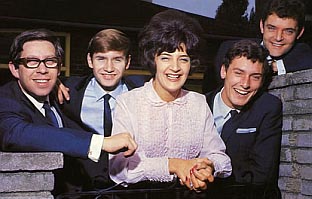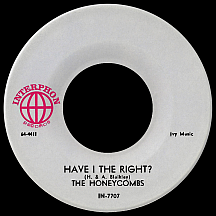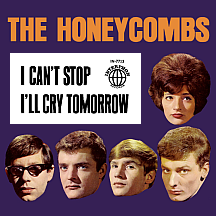THE HONEYCOMBS
Have I the Right?
Martin Murray was a hairstylist but also a guitar player who preferred making music over a daily shampoo-rinse-cut routine. So he formed The Sheratons in Hackney, a Northeast London borough, towards the end of 1963. Anne Margot Lantree, who went by the nickname "Honey," worked at his salon and wanted to be part of Martin's exciting new endeavor but first had to learn guitar herself. Turns out she was rhythmically more attuned to percussion so, disregarding the notion that girl drummers were a no-no, she got the nod. They knew of no precedent for such a configuration, though in actuality a number of female jazz drummers had been around since the 1930s, while the first such woman in a rock group appears to have been Claire Lane of The Ramrods, an American band known for the 1961 instrumental hit "(Ghost) Riders in the Sky." But Murray was impressed by Honey's skill, and her looks, and had a hunch that she just might attract more than the usual amount of attention to his fledgling group.
John Lantree wanted to get in on the fun his sister was having and joined as bassist. Lead guitarist Alan Ward and singer/harmonica player Denis Dalziel (who shortened his name to Denis D'Ell) completed the lineup. The early-twenty-something Sheratons landed gigs at area pubs, most notably the Mildmay Tavern on Balls Pond Road in North London where they met struggling songwriters Alan Blaikley and Ken Howard. The quintet had already scheduled an audition with producer Joe Meek (whose track record included U.K. chart-topper "Johnny Remember Me" by John Leyton and The Tornadoes' worldwide smash "Telstar"). Alan and Ken pitched one of their songs, "Have I the Right?," hoping that in Meek's hands it might develop into a hit.
Meek, by consensus one of the most eccentric of music entrepreneurs, saw the group as a hungry young bunch willing to be molded in any way he saw fit. Recording them in the spring of 1964 at his flat on Holloway Road in Islington (just a couple of miles from the Mildmay), he applied his usual offbeat techniques to the making of "Have I the Right?," adding plenty of reverb and a foot-pounding sound accomplished by lining up the five on the stairway of the apartment building and telling them to stomp away. D'Ell didn't much care for Meek's producing style, convinced he "...ended up sounding like Mickey Mouse" on the speeded-up finished take, but he wasn't really in a position to complain...especially when the record started to take off.
The master was sold to Pye Records, one of Britain's top labels at the time, and the band was given a new name, The Honeycombs (Louis Benjamin, an executive at Pye, had jokingly suggested merging Honey's name with her former hairstyling job). The BBC wasn't particularly impressed with the song but offshore Pirate stations jumped on it, if only to defy the "Powers That Be" (one of the chief goals of Pirate Radio). The single was a runaway hit, topping the U.K. charts in August '64 and spreading from there across the globe; in the U.S. it was released on Interphon, a newly-contrived subsidiary of Vee-Jay (the company that had stumbled into an unexpected windfall with several Beatles masters licensed to them the previous year), and hit the top ten in October.
Alan and Ken (usually credited as Howard Blaikley or H. & A. Blaikley) penned the follow-up, "Is it Because," a top 40 U.K. hit. The American label opted to go with the Honeycombs' take on the duo's "I Can't Stop," a strong track despite sounding very similar to its hit predecessor; released in the fall, it peaked in the top 50 in January '65. The group had been on a rigorous world tour since summer that included appearances on European and American television. Pop Gear (U.S. title: Go Go Mania) hit theaters around this time and featured them lip-synching to "Have I the Right?" and fourth single (but non-hit) "Eyes." After another unsuccessful 45 ("I Don't Love You No More"), they covered The Kinks' "Something Better Beginning" and returned to the British top 40 in the spring of '65. With bankruptcy hovering over the heads of Vee-Jay owners Vivian Carter and James Bracken, Interphon ceased to exist; later singles came out in the U.S. on Warner Bros.

The band's final hit was "That's the Way," a midtempo ballad with a lead vocal by Denis and an added bonus: Honey sang on the track! The record nearly reached the U.K. top ten in the summer of 1965, a misleadingly promising development as there were no follow-up hits. Feeling he'd lost any control he originally had, group founder Murray left the band and was replaced on rhythm guitar by Peter Pye, who had recently filled in while Murray recuperated from injuries inflicted at a show by overly-enthusiastic fans. Ward and D'Ell bailed in '66 and the Lantree siblings continued with three new members, singer-guitarist Colin Boyd, lead guitarist Rod Butler and keyboard player Eddie Spence.
Being a "mad genius" often comes at a price and Joe Meek is one of music history's more bizarre representatives. A drug habit that got out of hand as the decade progressed put him in a serious downward spiral; he often heard voices that weren't really there and was known to wander the streets half-dazed. On February 3, 1967, the 37-year-old got into an argument with his landlady about the rent payment. His assistant, Patrick Pink, was inside the flat and heard a shot. Coming within view, he saw that Meek had fired a shotgun, point-blank, at the woman. Patrick then stood aghast as Joe turned the gun on himself.
The news of Meek's death hit The Honeycombs hard and they disbanded soon afterwards. D'Ell (spelling his name Dennis D'Ell) signed with CBS, a cover of Little Anthony and the Imperials' "Better Use Your Head" his best-known song. Martin Murray recorded for Pye with two short-lived groups, The Lemmings and The College Boys. Honey Lantree attempted to put together an all-girl rock band but had difficulty finding enough musicians with the talent to make it come together; her musical vocation, it seemed, was something of a rarity in those days. She gave up trying soon afterwards, as did her brother. Peter Pye made records (as Peter Franc) in the early 1970s. Alan Blaikley and Ken Howard composed many hits, scoring another U.K. number one, "The Legend of Xanadu" by Dave Dee, Dozy, Beaky, Mick and Tich, in 1968; Elvis Presley released his version of a Howard-Blaikley song, "I've Lost You," in 1970. The two managed a group called The Honeycombs in the 1970s, but other than their involvement, the act had no connection to the original, unusual hitmaking girl drummer and four guys.



